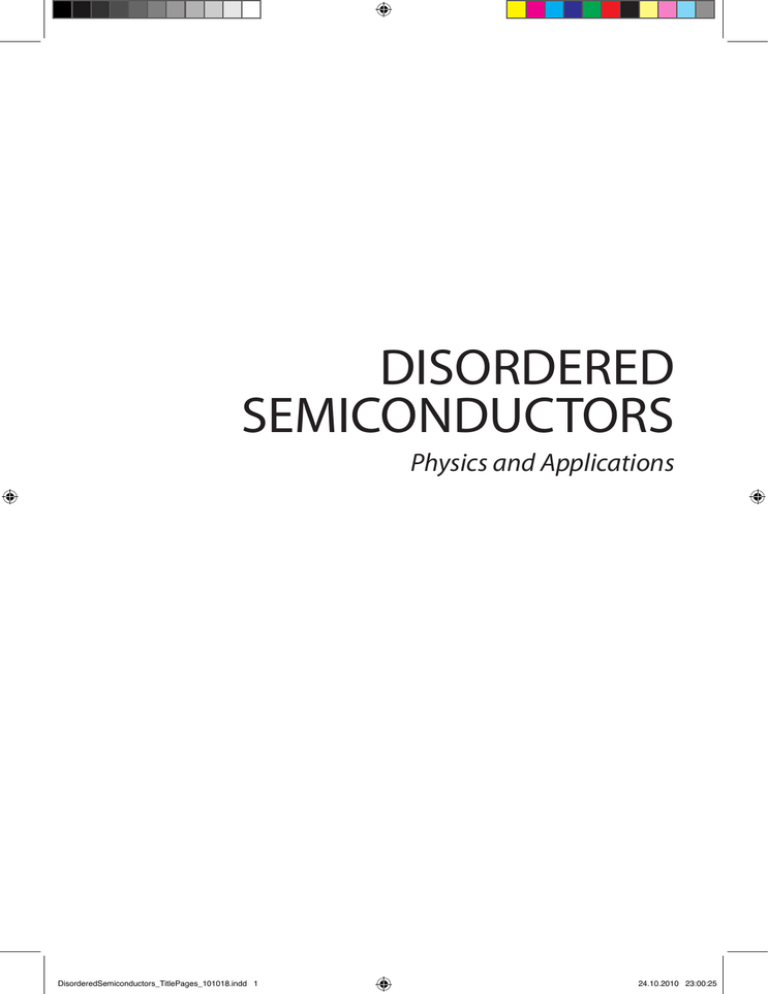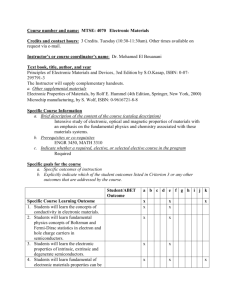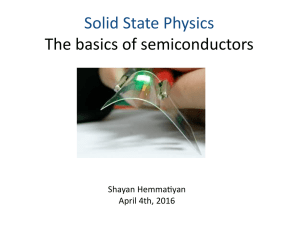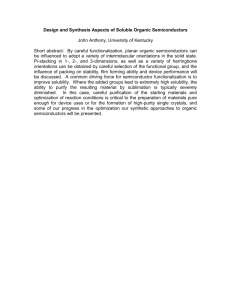
DISORDERED
SEMICONDUCTORS
Physics and Applications
DisorderedSemiconductors_TitlePages_101018.indd 1
24.10.2010 23:00:25
DISORDERED
SEMICONDUCTORS
Physics and Applications
Anatoly Popov
Moscow Power Engineering Institute
(Technical University)
Published by
Pan Stanford Publishing Pte. Ltd.
Penthouse Level, Suntec Tower 3
8 Temasek Boulevard
Singapore 038988
E-mail: editorial@panstanford.com
Web: www.panstanford.com
British Library Cataloguing-in-Publication Data
A catalogue record for this book is available from the British Library.
Cover designed in consultation with Gavron Designs (gavrondesigns.com), Seattle, Washington, USA.
HANDBOOK OF DISORDERED SEMICONDUCTORS: PHYSICS AND APPLICATIONS
by: Anatoly Popov
Copyright © 2011 by Pan Stanford Publishing Pte. Ltd.
All rights reserved.
All rights reserved. This book, or parts thereof, may not be reproduced in any form or by any means, electronic or
mechanical, including photocopying, recording or any information storage and retrieval system now known or to
be invented, without written permission from the Publisher.
For photocopying of material in this volume, please pay a copying fee through the Copyright Clearance
Center, Inc., 222 Rosewood Drive, Danvers, MA 01923, USA. In this case permission to photocopy is
not required from the publisher.
ISBN: 978-981-4241-76-2 (Hardcover)
ISBN: 978-981-4241-82-3 (eBook)
Printed in Singapore.
Preface
The concepts of translational symmetry and long-range order of atomic arrangement present in single crystals, are the pillars of modern solid state physics.
However, single crystals are a very special case of the solid state. Translational
symmetry and long-range order of atomic arrangement are absent in most materials. Therefore, the future of solid state physics is in developing a theory that
would describe the different states of matter including the theory of single crystals
as a special case. Besides the academic interest, materials without long-range order
in atomic arrangement are important from the application point of view. Devices
based on disordered semiconductors have very wide application. It is difficult
to imagine modern life without electrophotographic printers and copiers, liquid
crystal displays and monitors, optical discs, cheap solar cells and many other
devices based on disordered semiconductors.
However, the peculiarities of disordered semiconductors call for new approaches to the device design as compared to traditional single crystal materials.
For example, absence of long range order in structural network allows to apply
new methods of properties control without any doping (i.e. structural modification
of properties). Moreover, with a correct approach the so called inherent disadvantages of disordered semiconductors can be used to the advantage of the device. For
example, low charge carrier mobility allows to combine high resistivity of material
with photosensitivity in visible part of spectrum and to create electrophotography
printers and copiers. Therefore, the goal of this textbook is to link characteristic
features of disordered semiconductors’ atomic and electronic structures to the
device design process.
The textbook has seven chapters. In the first three chapters we discuss the
general concepts of disordered semiconductors, atomic structure of these materials
and the structure of energy bands, defects, as well as their electrical, optical
and photovoltaic properties. Success of semiconductor device design is defined
to a large extent by the possibility of material properties control. Since weak
sensitivity to impurities is a distinguishing feature of disordered semiconductors,
methods of property control are discussed in chapter four. Use of disordered
semiconductors in a device is usually limited to thin films. Such films must have
predefined properties and preparation methods must guarantee reproducibility
of these properties. These questions are discussed in chapter five. Application
of disordered semiconductors in various devices is considered in chapters six and
seven. The textbook is based on lectures given by the author to students in the field
of electronics and microelectronics at the Moscow Power Engineering Institute
Disordered Semiconductors: Physics and Applications by Anatoly Popov
Copyright © 2011 by Pan Stanford Publishing Pte. Ltd.
www.panstanford.com
978-981-4241-76-2
vi
Preface
(Technical University) and on the series of lectures given by the author at the
Samsung Advanced Institute of Technology.
This textbook is intended for undergraduate-level and graduate-level students
in the field of electrical and electronic engineering, nano-electronics, material
science and solid state physics. The book is also useful for researchers working
in the field of disordered semiconductors.
I am grateful to the Elsevier, Nature Publishing Group, Oxford University
Press, Taylor & Francis Group, World Scientific Publishing Co. and Institute
of Electrical and Electronics Engineering, Inc. (IEEE) for their permission to
reproduce copyright materials. I also wish to thank Dr. Mitsuhiro Kurashige for
his aerial photographs not published before. And I am particularly grateful to my
sons Dr. Igor Popov and Mr. Alex Popov for their help in preparing the manuscript
and helpful discussions.
Anatoly Popov
Moscow Power Engineering Institute
Contents
Preface
v
Contents
vii
1
1. Introduction
1.1
1.2
1.3
Definition of Disordered State . . . . . . . . . . . . . . . . . . . . . .
Classification of Non-crystalline Systems . . . . . . . . . . . . . . .
Qualitative and Quantitative Characteristics of
Glass-Formation . . . . . . . . . . . . . . . . . . . . . . . . . . . . . .
Structural Characteristics of Solids . . . . . . . . . . . . . . . .
Short Range and Medium Range Order . . . . . . . . . . . . .
Methods of Investigation of Disordered System Structure . . .
Simulation of Disordered Material Structure . . . . . . . . . .
Results of Structural Research of Disordered Semiconductors .
2.5.1 Atomic Structure of Non-crystalline Selenium . . . . .
2.5.2 Atomic Structure of Chalcogenide Glasses . . . . . . .
2.5.3 Atomic Structure of Amorphous Silicon . . . . . . . .
.
.
.
.
.
.
.
.
.
.
.
.
.
.
.
.
.
.
.
.
.
.
.
.
3.2
3.3
3.4
Electronic Structure . . . . . . . . . . . . . . . . . . . . . .
3.1.1 Localized States in Disordered Semiconductors .
3.1.2 Models of Energy Bands . . . . . . . . . . . . . .
3.1.3 Defect States in Disordered Semiconductors . . .
3.1.4 Electronic Structure of Hydrogenated
Amorphous Silicon . . . . . . . . . . . . . . . . .
Electrical Properties of Disordered Semiconductors . . .
3.2.1 Electrical Conductivity . . . . . . . . . . . . . . .
3.2.2 Thermoelectric Power and Hall Effect . . . . . . .
3.2.3 Time of Flight Method . . . . . . . . . . . . . . .
Optical Properties of Disordered Semiconductors . . . .
Photoelectrical Properties of Disordered Semiconductors
.
.
.
.
.
.
.
.
.
.
.
.
.
.
.
.
.
.
.
.
.
.
.
.
41
41
42
44
.
.
.
.
.
.
.
.
.
.
.
.
.
.
.
.
.
.
.
.
.
.
.
.
.
.
.
.
.
.
.
.
.
.
.
.
.
.
.
.
.
.
51
52
52
56
58
60
64
4. Methods for Controlling Properties of Disordered Semiconductors
4.1
4.2
13
14
18
22
29
29
35
38
41
3. Electronic Structure and Properties of Disordered Semiconductors
3.1
8
13
2. Atomic Structure of Disordered Semiconductors
2.1
2.2
2.3
2.4
2.5
3
4
69
Doping of Hydrogenated Amorphous Silicon . . . . . . . . . . . . . 70
Chemical Modification of Chalcogenide Glassy
Semiconductor Films . . . . . . . . . . . . . . . . . . . . . . . . . . . 73
vii
viii
Contents
4.3
4.4
Conductivity Type Inversion in Bulk Glassy Chalcogenide . . . . .
Structural Modification of Disordered
Semiconductors Properties . . . . . . . . . . . . . . . . . . . . . . . .
4.4.1 Structural Modification at the Level of Short Range Order .
4.4.2 Structural Modification at the Medium Range Order Level
4.4.3 Structural Modification at the Morphology Level . . . . . .
4.4.4 Structural Modification at the Defect Subsystem Level . . .
4.4.5 Correlation Between Structural Modification and
Stability of Material Properties and Device Parameters . . .
5.2
5.3
5.4
5.5
Technological Distinctions of Chalcogenide Glassy
Film Preparation . . . . . . . . . . . . . . . . . . . . . . . . .
Preparation of Hydrogenated Amorphous Silicon Films by
Glow Discharge Decomposition Method . . . . . . . . . . . .
Preparation of AIV BIV Alloys on the Base of Hydrogenated
Amorphous Silicon . . . . . . . . . . . . . . . . . . . . . . . .
Preparation of Hydrogenated Amorphous Silicon Films by
Chemical Vapor Deposition (CVD) Methods . . . . . . . . .
Preparation of Hydrogenated Amorphous Silicon Films by
Radio-frequency Sputtering Method . . . . . . . . . . . . . .
6.2
. . . . 100
. . . . 108
. . . . 110
. . . . 112
Devices Based on Charge Pattern Recording . . . . . . . . . . . . .
6.1.1 Electro-photographic Process . . . . . . . . . . . . . . . . .
6.1.2 Semiconductor Materials for Photoreceptors . . . . . . . . .
6.1.3 Multi-layers and Variband Photoreceptors . . . . . . . . . .
6.1.4 Photo-Thermoplastic Films . . . . . . . . . . . . . . . . . . .
6.1.5 Vidicons on the Basis of Disordered Semiconductors . . . .
Devices based on Photo-induced Transformations in
Chalcogenide Glasses . . . . . . . . . . . . . . . . . . . . . . . . . . .
6.2.1 Photo-structural Changes in Glassy Semiconductors . . . .
6.2.2 Photo-induced Metal Dissolution in Chalcogenide Glasses
6.2.3 Photo-induced Phase Transitions . . . . . . . . . . . . . . .
7. Photoelectric and Electronic Devices Based on Disordered
Semiconductors
7.1
7.2
88
. . . . 91
6. Optical Information Storage and Transmission Devices
6.1
76
77
81
84
86
91
5. Preparation Methods of Disordered Semiconductor Films
5.1
74
115
115
118
122
126
127
128
131
131
140
141
147
Photovoltaic Devices . . . . . . . . . . . . . . . . . . . . . . . . . . . 147
Switching and Memory Devices on the Basis of
Chalcogenide Alloys . . . . . . . . . . . . . . . . . . . . . . . . . . . 158
7.2.1 Threshold Switching Effect in Chalcogenide
Glassy Semiconductors . . . . . . . . . . . . . . . . . . . . . 158
Contents
7.2.2
7.3
Bistable (memory) Switching in Chalcogenide Glassy
Semiconductors . . . . . . . . . . . . . . . . . . . . . . . . . 164
7.2.3 The Second Generation of Phase-change Memory Devices 168
Silicon Thin Film Transistors . . . . . . . . . . . . . . . . . . . . . . . 172
Conclusion
179
References
181
Color Inserts
191
Index
199
ix





